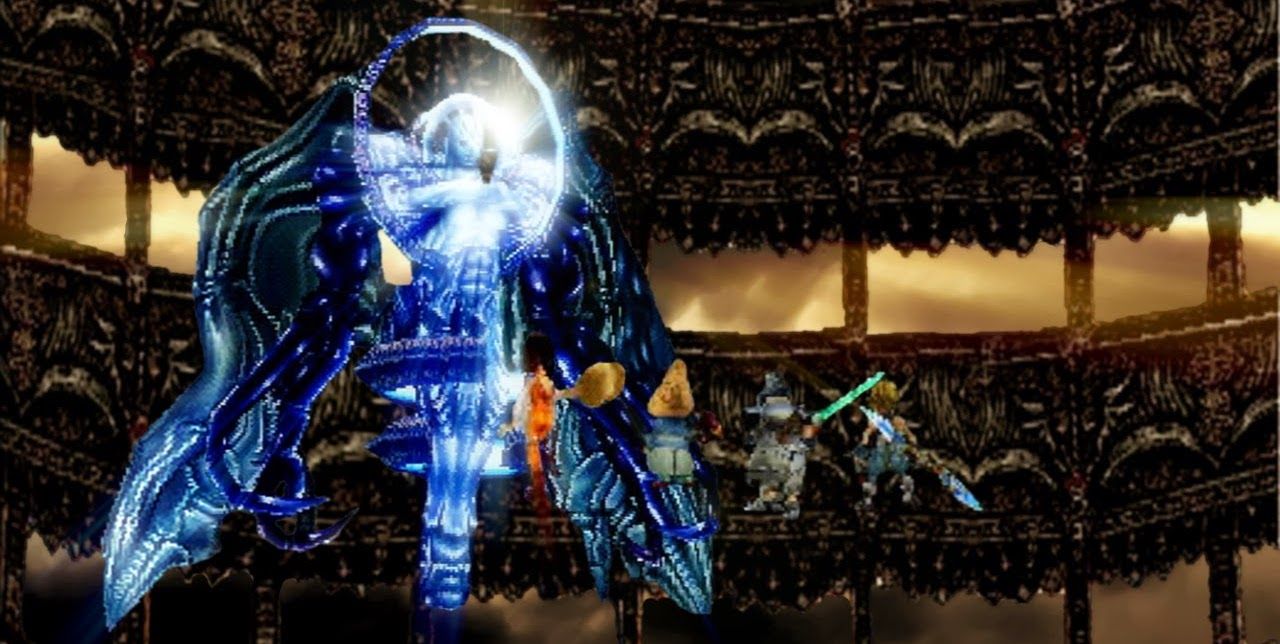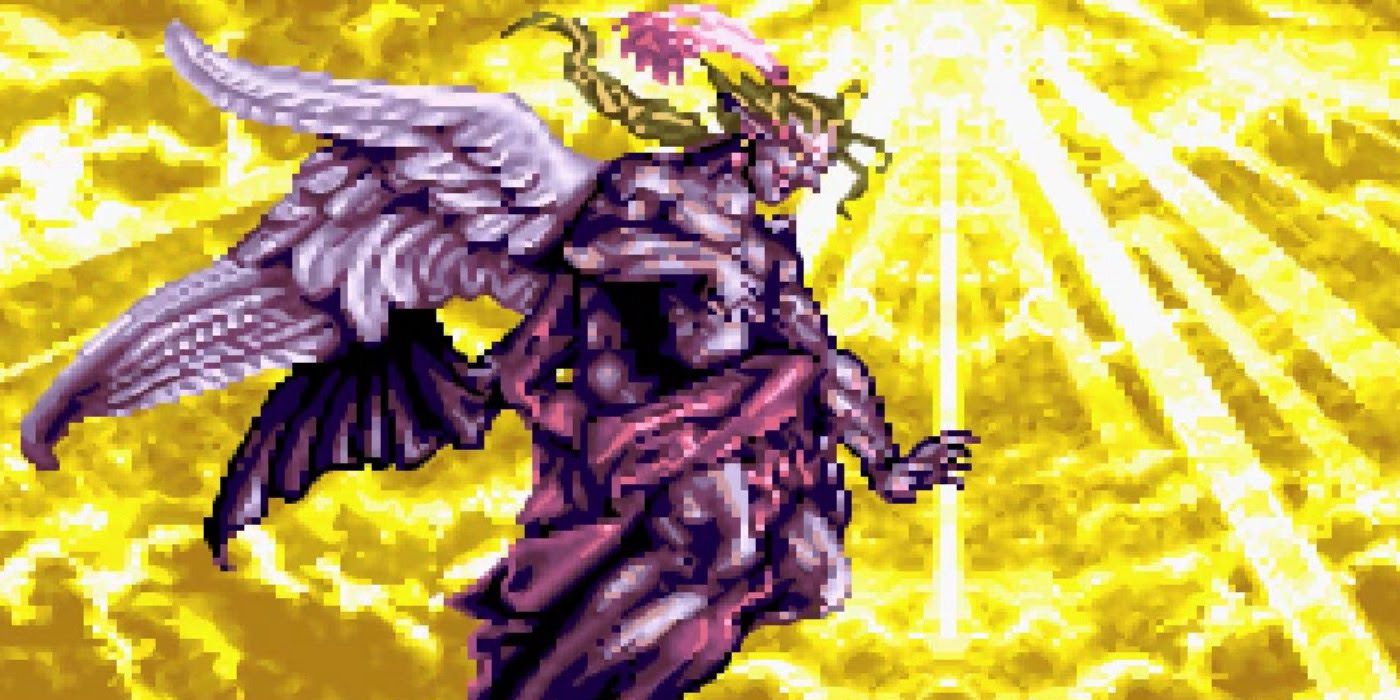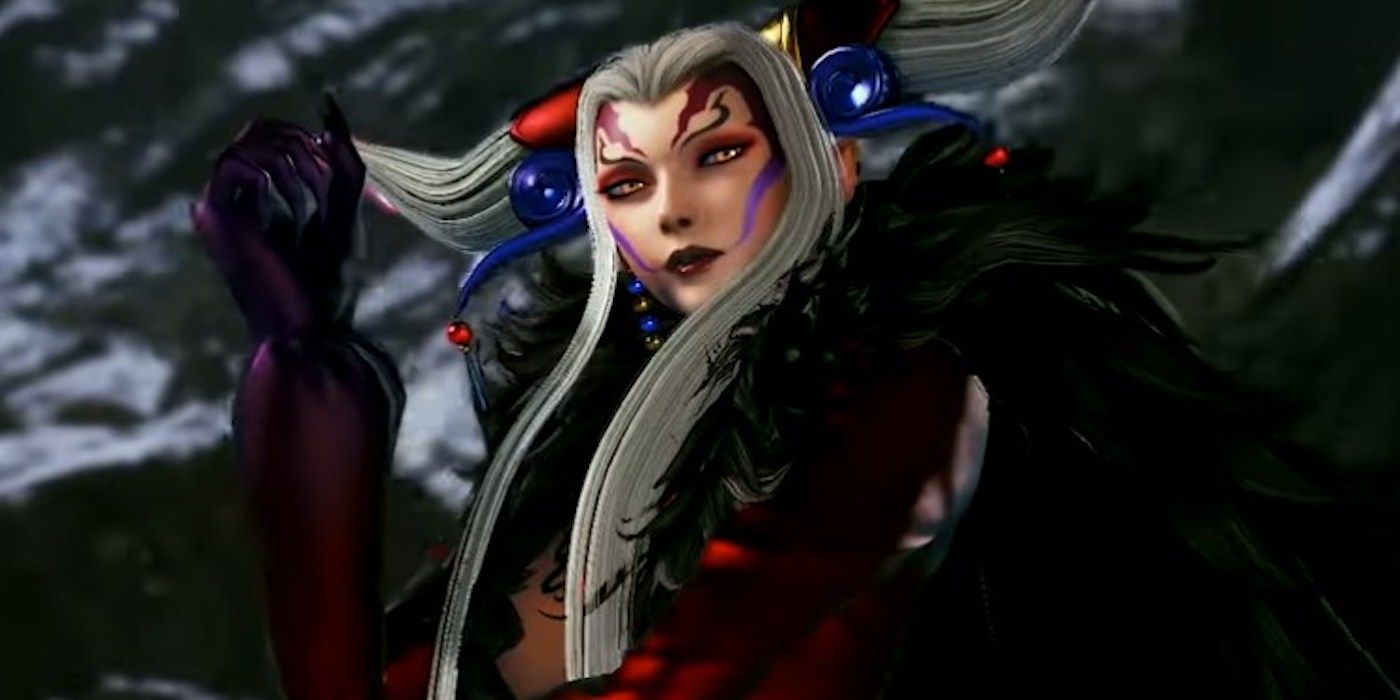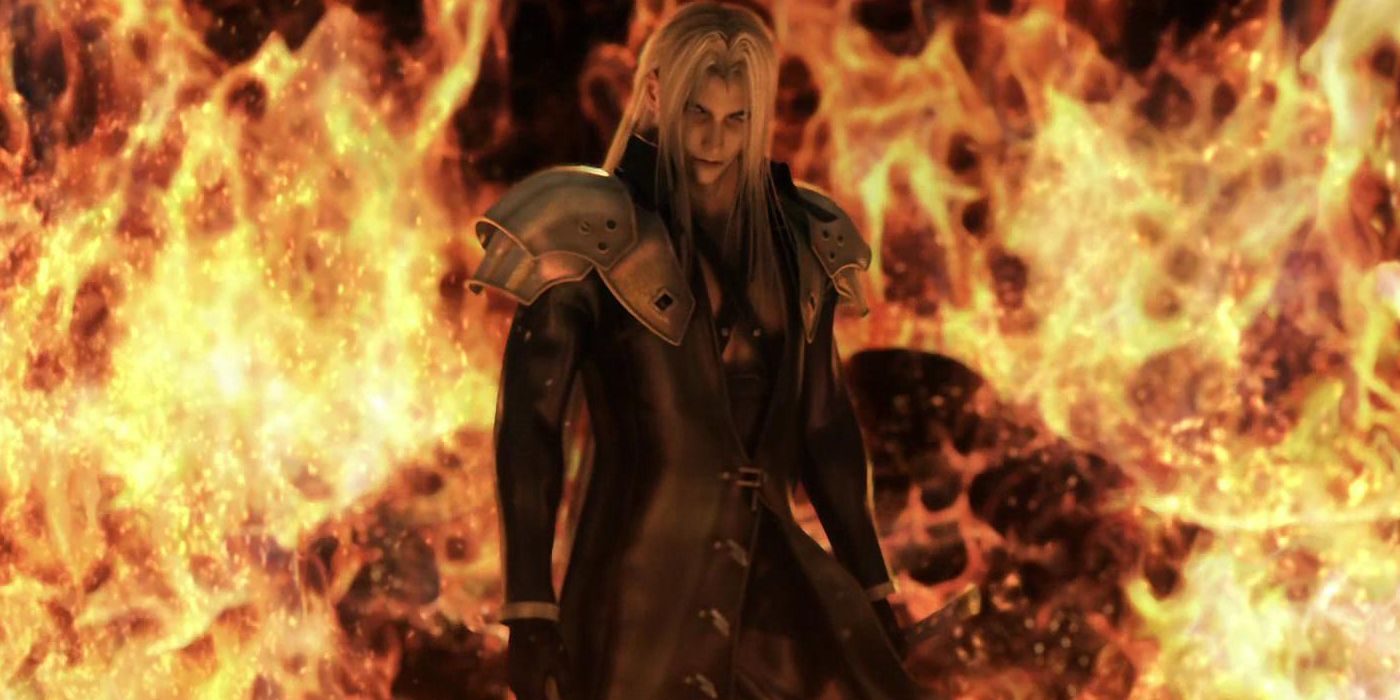
The Final Fantasy series was once limited by hardware restrictions when it came to designing the main characters, as they had to be a certain size and needed to feature multiple sprites/poses in order to be functional. The monsters of the Final Fantasy series were under no such restrictions, which meant that they could be much larger and more intricately designed than the playable characters that appeared in each game.
It was this desire to create bizarre and interesting looking monster designs that led to many Final Fantasy villains pulling out a monstrous transformation at the last minute so that they would look cool during the final battle.
The need for Final Fantasy villains to be impressive during the final battle has led to some frustrating last moment swerves in terms of the story, which have diminished some villains, while making others seem more impressive. You can't just dump a creepy looking anime monster at the end of a Final Fantasy game and call it a day, as the player has to be engaged enough in order to want to beat them.
The final boss also can't be too easy or frustratingly hard, which can be difficult to gauge due to how most players move at their own pace and some will be more prepared than others when the last battle comes.
We are here today to determine which Final Fantasy villains helped to turn their games into classic titles and which ones only brought the review scores down - from the monster who stole the spotlight from Kuja to the angel that wants to destroy the world.
Here are the 10 Main Final Fantasy Bosses That Hurt The Games (And 10 That Saved Them)!
20 Hurt: Necron

The PlayStation era of Final Fantasy titles had some incredible villains and Kuja ranks highly among them. Kuja was responsible for bringing much of the world to heel, which he did by manipulating Queen Brahne from the shadows and offering her magical weapons that were beyond the scope of what any other kingdom in the realm could bring to bear.
The rivalry between Zidane and Kuja comes to a head at the end of the game, with a final epic battle... that is followed by another battle against a new villain who was never mentioned before.
Necron is a representation of darkness and destruction who shows up for no other reason than to be a big boss monster. Necron steals the spotlight from Kuja for the sake of extending the final boss battle by another phase. The last confrontation in Final Fantasy IX should have involved Kuja, instead of some new guy who exists for no other reason than to look cool.
19 Saved: Exdeath

There is a problem among the Final Fantasy series, where an awesome villain will be built up as a major threat, only to be displaced by a cosmic-level entity at a late stage in the story. Exdeath managed to buck the trend by being established as the cause of the destruction of the crystals at an early point in the game and remaining a consistent threat until the final battle against him.
Exdeath also wins points for the two phases of his final battle, the first of which shows him in his true form - a colossal tree that has been mutated by the souls of evil beings, and the second which shows a more human-like Exdeath mounted on the fused bodies of his deceases servants, in what is still one of the most disturbing looking creatures in the series.
18 Hurt: The Cloud Of Darkness

Cloud of Darkness has zero personality and is just a representation of the void in a female form. Final Fantasy III is more of a series of smaller stories and quests rather than a cohesive whole, so Cloud of Darkness doesn't play much of a role until the end of the game.
The problem with the final battle against the Cloud of Darkness in the original Famicom version of the game is that she only has a single attack - Flare Wave, which deals a ton of damage in a single hit. The original version of Final Fantasy III offers a lot of job choices, but most of these are useless unless you are willing to hit level 99, as your party needs to be built in such a way that it can survive the endless barrage of Flare Wave attacks.
17 Saved: Kefka

Kefka was unique among the Final Fantasy villains when he first appeared in Final Fantasy VI, as he was kind of like the Joker of the franchise. Kefka was a crazed psychopath who loved nothing more than destruction, yet he could be funny in his reactions when people didn't respect him, as well as in his disregard for human life.
The final boss battle against Kefka is a fitting end to the Super Nintendo era of the Final Fantasy series.
During the fight, the background scrolls up the Statue of the Gods as we see images of Kefka's rise to divinity, before we face him in all of his splendor, as he takes on an image that makes a mockery of angelic beings. The only real complaint about the final fight against Kefka is that it's a tad too easy, which is linked to how simple it is to create broken combos of abilities and items in Final Fantasy VI.
16 Hurt: Zeromus

Final Fantasy IV had a great villain in the form of Golbez, who was very much a clone of Darth Vader, but he was supplanted at a late stage in the game by a creature known as Zemus, who was a wizard who lived on the moon and wanted to use his powers to take over the world. The sad thing is that you don't even get to fight Zemus, as Golbez and FuSoYa deal with him in a cutscene battle. You are left to fight a creature called Zeromus, who is a manifestation of Zemus' hatred.
Zeromus takes on the form of an R-Type boss and exists only to be an end boss battle. There is no reason why Golbez (a far superior character) shouldn't have remained the villain throughout the game. There is also no reason why Zemus should have been jobbed out so quickly.
15 Saved: Ultimecia

Final Fantasy VIII may be the easiest game in the series, due to how simple it is to use the Junction System to make unstoppably powerful characters at an early point in the story. All of the hacks in the world go out of the window when you face Ultimecia for the final time, as she forces you to use a lineup of random party members, which means that you will have to spread your resources across the group, unless you don't mind them being permanently removed from the battle when they croak.
Ultimecia also has the ability to destroy your Guardian Forces, along with all of their junctioned abilities and spells. This restricts your options as the battle goes on. Ultimecia would have been vastly improved if it turned out that she was Rinoa from the future, but that prominent fan theory was denied by Yoshinori Kitase.
14 Hurt: Ultima The High Seraph

Final Fantasy Tactics had an incredible battle system that was backed up by an amazing story of medieval warfare in a magical world. It's revealed that many prominent political figures are being manipulated by demons known as the Lucavi, as they are looking for an appropriate host body that can be used to bring back their leader - Ultima, the High Seraph.
The issue with the battle against Ultima, the High Seraph is that it's far too easy.
This is part of a larger issue of the second of half of Final Fantasy Tactics being a lot easier than the first half, due to the overpowered story characters you are given for free. The only way to make the final battle against Ultima, the High Seraph interesting is by intentionally going in with a weak party.
13 Saved: Chaos

You spend most of your time in the original Final Fantasy dealing with the Four Fiends, who have corrupted the natural elements of the world and need to be defeated. It's not until the final room in the game that you realize that Garland, the first boss you fought, is the true threat, as he absorbs the powers of the Four Fiends and transforms into Chaos.
Chaos isn't given much time to leave an impression, but his epic battle makes for an exciting ending to the game. The fight against Chaos requires a degree of planning on behalf of the party, as he has access to the most powerful elemental spells in the game and can inflict status effects with his physical attacks and special abilities. Chaos would go on to have a larger role in the Final Fantasy multiverse, but nothing will top the original final battle against him.
12 Hurt: Yu Yevon

Final Fantasy X had some tremendous villains, like the colossal whale monster known as Sin, and the flamboyantly sadistic Seymour Guado. Seymour and Sin are little more than roadblocks to the true villain of Spira who has been manipulating events from the shadows for centuries so that he can continue a cycle of violence that keeps him immortal.
This monster is known as Yu Yevon... and he's a big bug that you can't lose against without trying really hard, as the party has Auto-Life throughout the battle. The final epic struggle of Final Fantasy X is little more than an extended formality, as you wear down Yu Yevon and his annoying Yu Pagodas until they are destroyed. If the developers weren't going to turn Yu Yevon into a true threat, then they should have just offed him in a cutscene and let Braska's Final Aeon be the final boss.
11 Saved: Emperor Mateus

The developers of the Final Fantasy series decided early on that they wanted each new mainline iteration to be its own story and have its own set of rules for how the world works. They proved this with Final Fantasy II being set in a different world and focusing more on the story, along with creating an entirely new battle system.
Final Fantasy II is one of the least-popular games in the series, which is partly due to its mechanics, but it does have an amazing villain.
Emperor Mateus manages to take over most of the world using the power of dark magic and even manages to transcend his own fate after being slain by the party. Mateus' plan involved beating up the devil and taking over the afterlife so that he could achieve godlike power, which means that the party has to venture into the realm of Pandemonium in order to face Mateus again for one final epic battle.
10 Hurt: Orphan

The Final Fantasy series often needs to come up with a reason for why the human-sized villains suddenly gain the power to turn into giant monsters for the final encounter in the game. Final Fantasy XIII didn't need to do this, as the main villain throughout the game is the fal'Cie called Barthandelus (in the form of Galenth Dysley) and he likes to turn into a giant monster when he faces the party.
Barthandelus is dumped near the end of the game for a mysterious fal'Cie called Orphan, who is a similar giant monster with religious themes but is presented as more childlike and less aware of the consequences of its actions, which means that it's far less satisfying to defeat in battle. It also doesn't help that Vanille can defeat Orphan with a single spell once it's staggered, making the battle a formality to those who are aware of the trick.
9 Saved: Shuyin

Those who have passed on in the world of Spira can continue living as an unsent if their will is strong enough. This was true of both Auron and Seymour, though both were eventually sent to the afterlife by the end of Final Fantasy X. Shuyin was the villain of Final Fantasy X-2 and was likely the most powerful unsent remaining in Spira. He is able to take control over the bodies of Nooj and Baralai, in order to awaken the machina known as Vegnagun.
In the final battle against Shuyin, the player is forced to fight against a character who uses the same techniques that they once wielded, as Shuyin fights using corrupted versions of Tidus' Overdrive attacks. Final Fantasy X-2 managed to subvert the usual giant end boss monster trope that the series had become associated with, for a far more engaging conflict against someone who was twisted by the love they once lost, rather than just a big insect.
8 Hurt: Chaos

In the Dissidia series, Chaos was turned from an evil knight who absorbed the spirits of demons into a godlike being with almost infinite power. Chaos was the end boss of the original Dissidia Final Fantasy. The fight against Chaos takes place in a tiny arena and the range of his attacks allows him to hit you from pretty much any location.
Chaos' attacks are unpredictable and are difficult to block, especially as the camera has trouble moving around such a small arena.
Chaos must be defeated three times in a row, which means that if you are defeated in the final round then you have to start over. This is made even more frustrating by the fact that Chaos becomes far stronger in the third round and can use the Utter Chaos/Brink of Delusion attacks to hit almost every part of the arena.
7 Saved: Cloud Of Darkness

The creation of Final Fantasy XIV meant that the world of Final Fantasy XI would eventually stop receiving updates, as Square Enix wanted players to move from the older MMO to the new one. The last expansion of Final Fantasy XI was called Rhapsodies of Vana'diel, which was meant to act as a send-off for the setting.
The final boss of Rhapsodies of Vana'diel is the Final Fantasy XI version of the Cloud of Darkness, which has to be stopped from dragging the world into the void due to an imbalance of light and darkness. Cloud of Darkness is a notoriously tough boss, but the fight against is meant to be as epic as possible, as its presence is meant to cap off over a decade of new story content in the world of Vana'diel.
6 Hurt: Seed Crystal

The end bosses of the Final Fantasy series usually have an interesting design, which is at least one positive thing that you can say about them, even if they have no personality and the battle against them is easy. The Seed Crystal that is fought at the end of the A Crystalline Prophecy expansion of Final Fantasy XI is just a big lump of crystal that floats in a single spot. This means that you can avoid a lot of its moves by just attacking it from a distance.
The Seed Crystal can summon Seed Thralls, which appear to be copies of the party members, but even these can't make up for what is one of the most painfully dull end boss battles in the Final Fantasy series.
5 Saved: Ardyn

Ardyn Izunia managed to take almost everything away from Prince Noctis, as he was responsible for the demise of Lunafreya, he was behind the destruction of the kingdom of Insomnia, and he managed to plunge the world into an eternal darkness that allowed monsters to roam freely. The player will likely want to give Ardyn a beatdown during the last encounter with him in Final Fantasy XV.
However, taking Ardyn on is easier said than done, as Ardyn possesses the same kind of powers that Noctis has, which turns the battle into a mirror match.
Ardyn possesses his own corrupted form of the royal arms and can even fly in the air using the Armiger move, which means that you will have to learn how to counter Noctis' own fighting techniques in order to survive.
4 Hurt: The Creator

Final Fantasy IV received a sequel in the form of The After Years, which followed the son of Cecil and Rosa as he begins his own journey to save the world from extraterrestrial forces. The villain of Final Fantasy IV: The After Years is a godlike being known as the Creator, who travels around in a floating moon and seeds worlds with crystals in order to encourage their growth.
The Creator isn't a particularly interesting villain and his final form looks like it was traced from Neo Exdeath, but the main reason he sucks so much is that it's implied that he destroyed the worlds of the other Final Fantasy games that appeared on the Famicom and Super Nintendo, as the True Moon contains creatures that were exclusive to those games, suggesting that he captured them when he reclaimed the crystals from that world and annihilated each planet.
3 Saved: Queen Remedi/Li-Grim

When Final Fantasy Tactics Advance was announced and the first screenshots of the game were revealed, there were many fans who believed that the game would be far lighter in tone than its predecessor. The story of Final Fantasy Tactics Advance turned out to be far darker than anyone imagined, as four children entered a fantasy realm that allowed them to escape from the depressing lives they were living in the real world.
The villain of Final Fantasy Tactics Advance is Li-Grim, who has taken on the form of Mewt's deceased mother in order to keep him in the world of Ivalice. The player has to take on Li-Grim in one of the hardest battles in the series, due to her ability to summon a random Totema with a single move and unleash it upon the party.
2 Hurt: The Undying

Final Fantasy XII managed to keep the spirit of Ivalice alive by bringing Game of Thrones style politics to a fantasy world. It's just a shame that the combat system didn't live up to the potential of the setting, as you eventually reached a point where the game just played itself. Final Fantasy XII had many powerful human-sized opponents who often gave the party more trouble than the giant monsters.
Vayne Solidor would have made for a fine end boss of Final Fantasy XII, as he was a constant thorn in the side of the party throughout the game and his ambition to become the new Dynast King gave him a far better motivation than most of the villains in the series.
The developers couldn't help themselves, though, and they had Vayne merge with an ancient spirit and take pieces of an airship into his body, which turned him into a ridiculous looking monster that looked like a rejected design from Tetsuo: The Iron Man.
1 Saved: Sephiroth

There were a few popular JRPGs on the Super Nintendo, such as Chrono Trigger and Final Fantasy VI, but the game that brought the genre to prominence was Final Fantasy VII on the original PlayStation. An entire generation of gamers was introduced to the crazy end bosses of the Final Fantasy series through the battle with Safer-Sephiroth at the end of Final Fantasy VII.
The entire battle with Safer-Sephiroth is memorable, from the moment when he floats down from the air in his monstrous new form to the swirling skies in the background, to the Latin chanting in his theme music, and the Supernova attack that involves destroying most of the solar system. There is one more battle with Sephiroth after the Safer-Sephiroth fight, but it's essentially a cutscene fight that is over in a single exchange of swords. This means that most fans consider the boss battle against Safer-Sephiroth to be the last in the game, as it's the final moment when you can lose.
---
Are there any other Final Fantasy bosses that we should've mentioned? Let us know in the comments!
from ScreenRant - Feed https://ift.tt/2CPMjiY


0 Comments